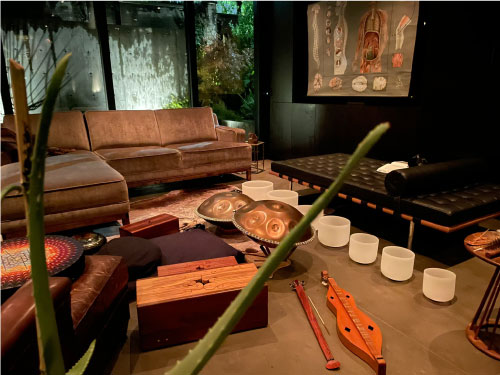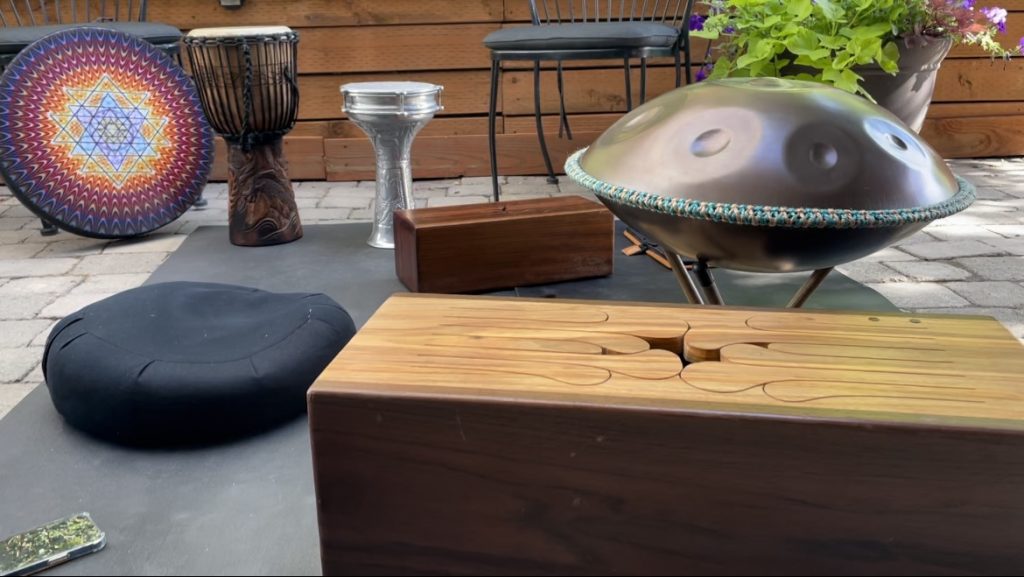SOUND BATHS
A sound bath is a meditative experience not all that dissimilar from a water bath. But instead of enveloping your body with warm water, you are being enveloped by resonant sounds chosen for their ability to encourage a deep sense of relaxation and wellbeing. A sound bath is a truly unique experience unlike anything else in the spiritual meditation realm.
Whether you are just curious about sound baths or ready to submerge yourself in a world of sound experience, we want you to know exactly what to expect before you get started. If you have any questions prior to your first session at Maloca Sound & Wellness, please do not hesitate to ask.



What is a Sound Bath
I like to describe the sound bath as a therapeutic experience whereby a person is immersed in resonant sound. The concept of resonance is based on the fact that sound waves interact with the environment in which they are produced. Sound waves bounce off objects, for example. They can be amplified, muted, and otherwise enhanced through this interaction.
The idea of resonant sound in a sound bath is to create an optimal resonance between instruments, practitioner, and participant. When optimal resonance is achieved, sound waves and vibrations are in perfect harmony. This is what encourages relaxation and spiritual healing.
How Sounds Are Produced
We speak of instruments in the realm of sound baths. However, don’t think in terms of electric guitars, pianos, and trumpets. Our instruments are carefully chosen for the types of sounds they produce and their ability to help us achieve optimal resonance.
Our instruments include things like singing bowls, percussion instruments, tuning forks, and the like. Many of them produce sounds that most people are subconsciously familiar with. Others create completely unique sounds participants have never heard before. As a practitioner, my goal is to combine the right instruments and sounds to create the desired bath.
Needless to say that not every sound bath is identical. Instruments and sounds can be combined in a variety of ways to achieve different results. With that in mind, each sound bath is somewhat of a unique experience.
Benefits of the Sound Bath
A sound bath’s efficacy is rooted in the ability that sound waves need to penetrate the body and stimulate the nervous system. For example, listening to resonant sounds often results in brain waves slowing. Why? Because the resonance achieved by combining sounds and instruments stimulate alpha wave production. This leads directly to physical relaxation and mental creativity.
The benefits of sound baths are numerous and varied. Here is a short list:
- Reduced stress and anxiety
- Improved mood
- Increased self-awareness
- Spiritual growth and healing
- Pain relief
- Improved sleep
Stress and anxiety reduction is perhaps the most visible benefit of the sound bath. Whether participants choose private sessions or attend healing retreats where sound baths are offered, we sound bath practitioners have the privilege of observing participants as they relax and get more in touch with themselves. We see people begin their sessions with a fairly high level of stress or anxiety only to finish being more relaxed than they have ever been.
A sound bath can be an important component to spiritual growth and healing for this very reason. Many people struggle to attain the level of growth or healing they desire because their minds are so distracted by other things. But participating in a sound bath changes the game. Through resonant sound that encourages relaxation and creativity, participants can let go of those distractions and get in touch with themselves at a deeper level. From that flows spiritual growth and healing.
Pain Perception and the Mind
Many sound bath participants experience a certain measure of pain relief following their sessions. How is this possible? It is related to the understanding that pain perception and the mind are intrinsically connected. More simply, a person’s thoughts about pain can influence their physical perceptions. If you expect that a particular experience is going to cause significant pain, you are likely to feel the kind of pain you were expecting.
Due to its ability to relax and encourage self-awareness, a sound bath can help change how a person thinks about pain. The more relaxed and self-aware a person is, the less heightened their pain perception.
Please note that sound bath practitioners cannot make any guarantees about pain relief. However, most of us have seen firsthand how sound baths can help with pain by encouraging participants to enter a deep state of relaxation and self-realization.
The History of Sound Baths
The sound bath is not a new concept. Historical records trace the belief in healing sound back to ancient cultures in India, Egypt, and Greece. Beginning with ancient India, a sound healing practice known as Nada Yoga was developed among practitioners looking to enhance yoga for deeper relaxation and improved meditation. Nada Yoga is still practiced today.
Ancient Egyptians were less likely to use instruments like gongs, tuning forks, and singing bowls, but they still knew of the healing power of resonant sound. History records ample evidence of Egyptian practices in which music and chanting was incorporated with temple ceremonies to achieve a heightened sense of spirituality.
In ancient Greece, it was a common belief that sound was an effective tool for both physical and mental healing. Verbal chanting and instrument-derived sounds were utilized as treatments for a variety of medical conditions, including pain, depression, and anxiety.
The Modern Sound Bath
It’s fair to say that the modern sound bath does not fully replicate the practices of ancient India, Egypt, and Greece. Rather, modern sound baths are a combination of ancient practices and modern adaptations. What we know as the sound bath today was born somewhere back in the late 1960s or early 70s. It is hard to put an exact date on things because so many people were trying so many ‘new ways’ of spiritual healing back then.
The sound bath practitioners of the era were mainly musicians who learned about the healing power of sound while practicing their craft. Many musicians became sound healers who experimented with a variety of instruments to create the resonant sounds we are so familiar with today. And a lot of what we do today can be traced back to one of the pioneers of sound bath healing, Don Conreaux.
Conreaux began his journey into sound healing as a teenager in the 1950s, when he studied under Paramahansa Yogananda. In his early adult years, he developed a few well-known practices, including Gong Yoga and the Gong Bath. He began hosting his own sound baths in the mid-1970s, mainly in California.
Time and Greater Understanding
Much of what was learned in the early days of the modern sound bath continues to be the foundation of modern practice. We still hold to the same principles introduced by Conreaux and his peers. But with time and greater understanding, we have been able to build on those principles. Modern sound bath practitioners are also the beneficiaries of those that came before them.
Sound baths have become increasingly popular among Gen Xers, millennials, and even the Gen Z culture. People from all walks of life interested in physical and spiritual healing are finding their way into the sound bath world. Sound baths are especially appealing to people who believe in a holistic approach rooted in a foundation of natural healing methods.
It goes without saying that sound baths have a long and well documented history. They have been used around the world as a natural means of encouraging good mental, spiritual, and physical health.
Sound Yoga and Its Instruments
Sound baths can be utilized on their own or combined with the principles of yoga. When the two are combined, you have the previously mentioned practice of Nada Yoga. Also known as sound yoga, Nada Yoga is often described as the ‘science of sound healing’.
Instrument choices are key to this particular type of yoga. By combining established yoga practices and the right instruments, practitioners can help participants experience deep relaxation and spiritual connection. And like sound baths alone, sound yoga can help increase self-awareness, improve mood, and relieve pain.
The Instruments
Sound healers are free to use whatever instruments they believe will produce the resonant sounds they seek. However, we practitioners tend to lean toward a core set of instruments that seem to work well for most sessions.
Instrument choices play a significant role in the benefits of any particular sound bath. I take great care to choose the right instruments for each session. Whether you are looking for an individual or group session, I believe sound therapy could benefit you through deeper relaxation and self-awareness.
Sound baths have been around for a long time. So have sound healers. I invite you to learn more about the sound bath concept as well as holistic and natural healing. Relaxing, reducing stress, and becoming more self-aware are all things we can achieve through natural, time-tested practices like sound healing.
- Singing Bowls – A singing bowl is a metal bowl capable of emitting a deep resonant sound that one can actually feel. Sound is produced by rubbing the bowl’s rim with a wooden striker. Sound waves can be modified by adding water to the bowl.
- Gongs – A gong is a large metal disc not unlike the large symbols you see in a marching band. However, gongs are not ‘played’ by striking two of them together. Rather, sound is produced by striking the gong with a mallet. Different frequencies are achieved through gongs of varying sizes. The type of mallet a practitioner chooses also affects a gong’s resonant sound.
- Tuning Forks – Guitar players and other types of musicians are familiar with tuning forks as tools for tuning their instruments. A tuning fork produces a pure sound when struck. And because tuning forks can be manufactured at a variety of frequencies, sound practitioners can strategically choose them to target different parts of the body.
- Wind Chimes – Bamboo, wooden, or metal wind chimes suspended loosely on frames produce a lovely and relaxing sound as the wind blows by. If you have ever had a wind chime on your own porch, you know how calming listening to it can be.
- Drums – A variety of drums are used in sound yoga and sound baths. The ocean drum is a favorite. But rather than beating it, the ocean drum is shaken to take advantage of beads found within. The beads create a sound reminiscent of waves crashing on the shore. It is a deeply relaxing sound.
Schedule your session:
SESSIONS WILL BE HELD IN-PERSON IN SALT LAKE CITY, UT AT A CONVENIENT LOCATION OF YOUR CHOICE, OR VIRTUALLY OVER ZOOM.
Package one
1 session
90 minutes
$222
Package Two
5 sessions
90 minutes each
$999
Package Three
10 sessions
90 minutes each
$1750